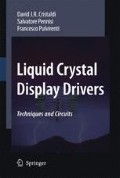Passive LCDs can be divided into two main groups: segmented LCDs and passivematrix LCDs (PMLCDs). The former are today used in monochromatic applications like simple calculators, digital watches and simple instrumentation and climate control equipments. They are not suitable for high-information-content and graphical applications because of their limited resolution. High-performance calculators, organizers, notebooks, portable computers, projectors and LCD-TVs, exploit almost invariantly active-matrix displays. Nonetheless, PMLCDs have still a market in applications that meet the following criteria: simple fabrication process, limited resolution, dimensions and price, 1 or 2 colors, and limited tolerable viewing angle. For instance, they are used in mobile telephones, Personal Digital Assistants (PDAs), word processors, automotive applications, logic analyzers, oscilloscopes, electrocardiographs, etc.
Access this chapter
Tax calculation will be finalised at checkout
Purchases are for personal use only
Preview
Unable to display preview. Download preview PDF.
References
O. Akimoto and S. Hashimoto, “A 0.9-in. UXGA/HDTV FLC Microdisplay,” SID Digest, Vol. 31, No. 1, pp. 194–197, 2000.
P.M. Alt and P. Pleshko, “Scanning Limitations of Liquid-Crystal Displays,” IEEE Transaction on Electron Devices, Vol. 21, No. 2, pp. 146–155, 1974.
K.G. Beauchamp, Applications of Walsh and related functions with an introduction to sequency theory, Academic Press, 1984.
A.R. Conner and T.J. Scheffer, “Pulse-Height Modulation (PHM) Gray Shading Methods for Passive Matrix LCDs,” Proceedings of Japan Display ’92, pp. 69–72, 1992.
P. Gulick and T. Mills, “Active Addressing(TM) of Passive Matrix Displays,” Information Display, Vol. 10, pp. 14–17, 1994.
H. Hirai, S. Kondo, A. Murayama, and H. Hatoh, “A New Driving Method for Crosstalk Compensation in Simple-Matrix LCDS,” Proceeding of Japan Display ’92, pp. 499–502, 1992.
Y. Hirai, A. Nakazawa, K. Kawaguchi, H. Motegi, H. Koh, T. Kuwata, Y. Nakagawa, T. Ohbiki, M. Noguchi, and H. Araki, “A Color STN-LCD for Video Display Using Amplitude-Modulation MLS Technology,” SID Digest, pp. 339–342, 1995.
H. Kawakami, H. Hanmura, and E. Kaneko, “Brightness Uniformity In Liquid Crystal Displays,” SID Digest, Vol. 11, pp. 28–29, 1980.
Y Kaneko, M Haraguchi, H Murakami, and H Yamguchi, “Crosstalk-Free Driving Methods for STN-LCDs,” SID Digest, Vol. 31, No. 4, pp. 333–336, 1990.
T. Kurumisawa and A. Ito, “Eliminating Moving Picture Cross-Talk by the Self-Calibrating Driving Method (SCDM),” SID Digest, pp. 33–36, 1997.
K.E. Kuijk, “Minimum-Voltage Driving of STN LCDs by Optimized Multiplerow Addressing,” Journal of the SID, Vol. 8, No.2, pp. 147–153, 2000.
H. Kawakami, Y. Nagae, and E. Kaneko, “Matrix Addressing Technology Of Twisted Nematic Liquid Crystal Display,” Proceedings of Biennial Display Conference, pp. 50–53, 1976.
B.W. Marks, “Power Reduction in Liquid-Crystal Display Modules,” IEEE Transactions on Electron Devices, Vol. 29, No. 12, pp. 1884–1886, 1982.
P. Maltese, “Cross-Modulation and Disuniformity Reduction in the Addressing of Passive Matrix Display,” Proceedings of Euro Display ’84, pp. 15–20, 1984.
P. Maltese, “Complex Polarity Sequences For Directly Driven Liquid Crystal Matrices,” Proceedings of Euro Display ’87, pp. 139–143, 1987.
H. Mano, S. Nishitani, K. Kondo, J. Taguchi, and H. Kawakami, “An Eight-Gray-Level Drive Method for Fast-Responding STN-LCDs,” SID Digest, pp. 93–96, 1993.
J. Nehring and A.K. Kmetz, “Ultimate Limits for Matrix Addressing of RMS Responding Liquid Crystal Displays,” IEEE Transactions on Electron Devices, Vol. 26, No. 5, pp.795–802, 1979.
S. Nishitani, H. Mano, and Y. Kudo, “New Drive Method to Eliminate Crosstalk in STN-LCDs,” SID Digest, pp. 97–100, 1993.
A. Nakazawa, K.Tamai, M. Nagai, M. Kitamura, Y. Hirai, S. Matsuoka, and Y. Soda, “Ultra-Low-Power STN-LCDs Using Multiple-Line Addressing for Mobile Telecommunication Applications,” Journal of the SID, Vol. 7, No. 4, pp. 277–280, 1999.
D. Prince, B. Clifton, T.J. Scheffer, and B. Leybold, “Identifying and Eliminating ‘Splicing’ in Multiple Line Addressed STN Displays,” Proceeding of Japan Display ’95, pp. 241–244, 1995.
K.G. Panikumar and T.N. Ruckmongathan, “An Addressing Technique for Displaying Restricted Pattern in RMS-Responding LCD’s by Selecting a Few Rows at a Time,” Journal of the SID, Vol. 8, No. 2, pp. 155–162, 2000.
K.G. Panikumar and T.N. Ruckmongathan, “A Controller for Liquid Crystal Displays in Logic Analyzers and Oscilloscopes,” IEEE/OSA Journal of Display Technology, Vol. 1, No. 1, 2005.
T.N. Ruckmongathan, “An LCD for Multitrace Oscilloscope,” SID Digest, pp. 128–131, 1986.
T.N. Ruckmongathan, “A Generalized Addressing Technique for RMS Responding Matrix LCDs,” Proceedings of International Display Research Conference, pp. 80–85, 1988.
T.N. Ruckmongathan, “Novel Addressing Methods For Fast Responding LCDs,” Reports of the Research Laboratory, Asahi Glass Company Ltd., Vol. 43, pp. 65–87, 1993.
T.N. Ruckmongathan and A.R. Shashidhara “Sparse Orthogonal Matrices for Scanning Liquid Crystal Displays,” Journal of Display Technology, Vol. 1, No. 2, 2005.
T.J. Scheffer and B. Clifton, “Active Addressing Method for High-Contrast Video-Rate STN Displays,” SID Digest, pp. 228–231, 1992.
I.A. Shanks and P.A. Holland, “Addressing Methods for Nonmultiplexed Liquid Crystal Oscilloscope Displays,” SID Digest, pp. 112–113, 1979.
S. Smorfa, M. Olivieri, R. Mancuso, and M. Lienhard, “A Physical-Level LCD Driver Model and Simulator with Application to Pixel Crosstalk Suppression,” IEEE Transactions on Consumer Electronics, Vol. 52, No. 3, pp. 1027–1034, 2006.
Y. Suzuki, M. Sekiya, K. Arai, and A. Ohkoshi, “A Liquid-Crystal Image Display,” SID Digest, pp. 32–33, 1983.
N. Sako, H. Sasama, H. Kitayama, and H. Fukasawa, “Single-chip Driver for 65k Color STN-LCD with Half Column Voltages in a MLA Drive System,” SID Digest, Vol. 34, No. 1, pp. 324–327, 2003.
M. Watanabe, “High Resolution, Large Diagonal Color STN for Desktop Monitor Application,” SID Digest, Vol. 34, pp. M81–87, 1997.
M. Watanabe, Y. Inoue, T. Ohaba, and K. Taniguchi, “High Resolution, Large Diagonal Color STN For The Desktop Monitor Applications,” International Display Research Conference, M–81–M87, 1997.
I. Washizuka and A. Sakamoto, “Driving Method to Reduce Shadowing for STN-LCD Module,” Proceedings of International Display Workshop, pp. 297–300, 1997.
Author information
Authors and Affiliations
Rights and permissions
Copyright information
© 2009 Springer Science+Business Media B.V.
About this chapter
Cite this chapter
Cristaldi, D.J., Pennisi, S., Pulvirenti, F. (2009). Passive LCDs and Their Addressing Techniques. In: Liquid Crystal Display Drivers. Springer, Dordrecht. https://doi.org/10.1007/978-90-481-2255-4_3
Download citation
DOI: https://doi.org/10.1007/978-90-481-2255-4_3
Publisher Name: Springer, Dordrecht
Print ISBN: 978-90-481-2254-7
Online ISBN: 978-90-481-2255-4
eBook Packages: EngineeringEngineering (R0)

